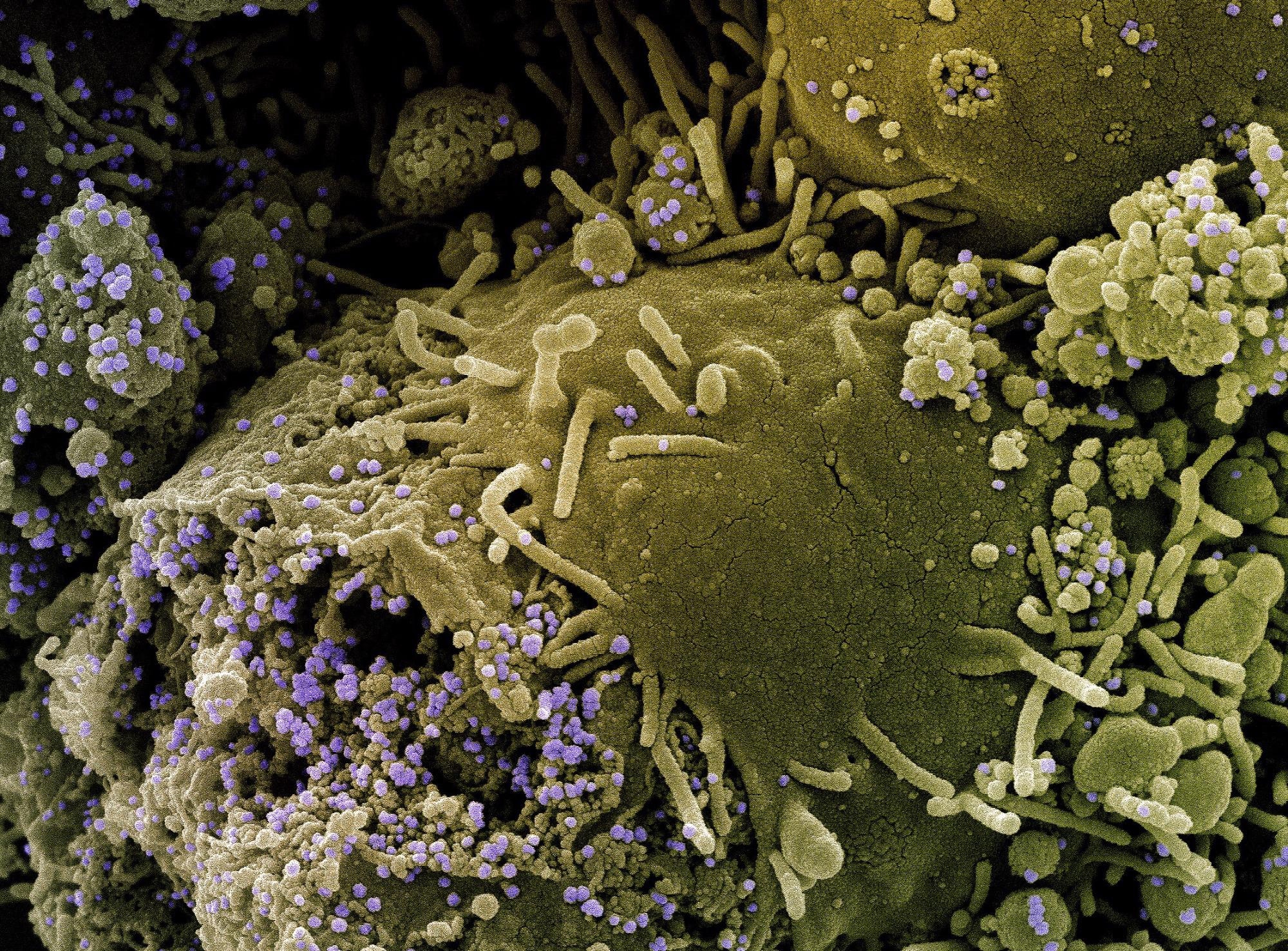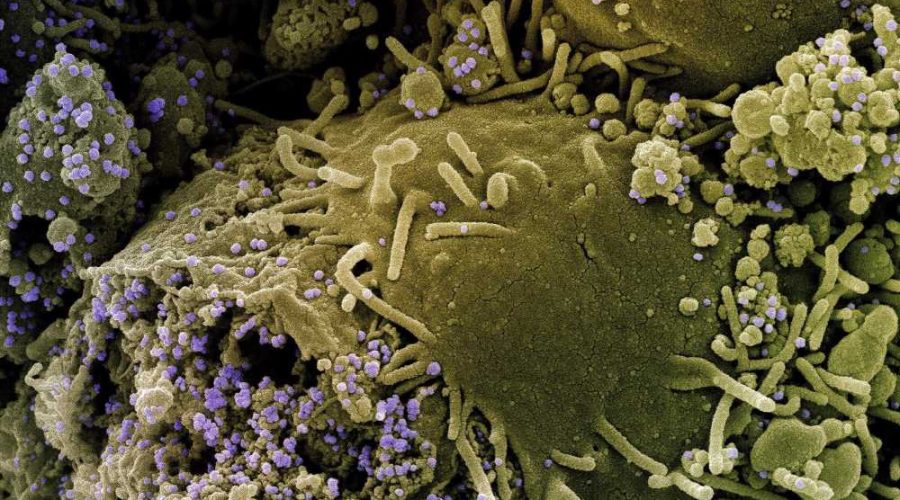SARS-CoV-2 is evolving adaptively in multiple regions of the genome
Scientists from the United States have recently assessed the evolutionary success of mutations accumulated across severe acute respiratory syndrome coronavirus 2 (SARS-CoV-2) genome. They have observed that the positively-selected mutations in the viral spike S1 subunit are primarily responsible for adaptive evolution. This indicates that the virus may undergo antigenic drift. The study has been published in the journal Cell Host & Microbe.
 Study: Rapid and parallel adaptive mutations in spike S1 drive clade success in SARS-CoV-2. Image Credit: NIAID
Study: Rapid and parallel adaptive mutations in spike S1 drive clade success in SARS-CoV-2. Image Credit: NIAID
Background
With the progression of the coronavirus disease 2019 (COVID-19) pandemic, the original lineages of SARS-CoV-2 have been replaced almost entirely by novel variants of concern (VOCs) and variants of interest (VOIs). Whole-genome sequencing studies have shown that these variants have evolved with improved fitness by acquiring positively selected mutations across the viral genome. This is called adaptive evolution, as these mutational changes make the virus suitable for its habitat.
A continuous adaptive evolution has been observed in seasonal influenza viruses and coronaviruses during their endemic circulation in the human population. The positive selection pressure derived from pre-existing population-level immunity against influenza virus has resulted in the acquisition of escape mutations in hemagglutinin, a viral protein responsible for viral transmissibility and antigenicity.
In the current study, the scientists have assessed the evolutionary dynamics of SARS-CoV-2 by analyzing genomic regions undergoing adaptive evolution. They have analyzed the viral genome data obtained between December 2019 and May 2021 to identify the genomic regions associated with adaptive evolution. Moreover, they have assessed the correlation between the accumulation of mutations in protein-coding genes and the evolutionary fitness of viral lineages.
Viral mutations associated with adaptive evolution
The comparison of mutation rates in different genomic regions revealed that the rate of accumulating nonsynonymous mutations (genetic mutations that change the amino acid sequence of encoded proteins) in the SARS-CoV-2 spike S1 subunit is considerably higher than synonymous mutations (silent mutations that do not change amino acid sequence of encoded proteins). Moreover, the highest ratio of nonsynonymous to synonymous divergence was observed in the S1 subunit. The nonsynonymous mutations were found to cluster temporarily in the S1 subunit. These findings indicate that nonsynonymous mutations in the S1 subunit are under positive selection and that mutation clustering in the S1 subunit represents a temporal structure to the SARS-CoV-2 adaptive evolution.
With further analysis, it was observed that the number of nonsynonymous mutations in the S1 subunit correlates positively with improved viral fitness. Besides the S1 subunit, mutations accumulated in non-structural protein 6 (Nsp6) were found to improve viral fitness. The analysis of other genomic regions revealed that despite having a high rate of accumulating nonsynonymous mutations, viral ORF8, S2 subunit, and nucleocapsid are not associated with improved viral fitness.
Taken together, these observations indicate that positively-selected mutations in the spike S1 are primarily driving the adaptive evolution of SARS-CoV-2 lineages.
Specific mutations associated with viral fitness
To identify specific mutations associated with improved viral fitness, the rate of occurrence of independent deletion and substitution mutations was compared with the average growth rate of all viral lineages containing these mutations.
The findings revealed that more than 80% of mutations occur just once during the ongoing viral evolutionary process. Of mutations that appeared more than 4 times, the majority were present in the spike S1 subunit. Three of these mutations (Spike:95I, Spike:452R, and ORF1a:3675-3677deletion) showed the highest impact on viral growth rate.
Of all identified mutations, ORF1a:3675-3677deletion appeared 8 independent times and is responsible for the deletion of three amino acids in Nsp6. Further analysis showed that the accumulation of mutations in the spike S1 subunit is associated with ORF1a:3675-3677deletion. These observations indicate that ORF1a:3675-3677deletion is an adaptive mutation that facilitates the process of SARS-CoV-2 evolution.
Study significance
The study demonstrates the evolutionary dynamics of SARS-CoV-2 during the ongoing COVID-19 pandemic. The findings indicate that improved fitness of emerging viral variants is associated with adaptive evolution, and not neutral evolution. Furthermore, a high rate of accumulation of nonsynonymous mutations in the spike S1 subunit is identified as the main driving force for viral evolution. Given these observations, the scientists suggest that similar to the influenza virus, SARS-CoV-2 may undergo antigenic drift.
- Kistler KE. 2022. Rapid and parallel adaptive mutations in spike S1 drive clade success in SARS-CoV-2. Cell Host & Microbe. https://www.sciencedirect.com/science/article/abs/pii/S1931312822001482
Posted in: Medical Science News | Medical Research News | Disease/Infection News
Tags: Amino Acid, Cell, Coronavirus, Coronavirus Disease COVID-19, covid-19, Evolution, Genes, Genetic, Genome, Genomic, immunity, Influenza, Mutation, Pandemic, Protein, Respiratory, SARS, SARS-CoV-2, Severe Acute Respiratory, Severe Acute Respiratory Syndrome, Structural Protein, Syndrome, Virus

Written by
Dr. Sanchari Sinha Dutta
Dr. Sanchari Sinha Dutta is a science communicator who believes in spreading the power of science in every corner of the world. She has a Bachelor of Science (B.Sc.) degree and a Master's of Science (M.Sc.) in biology and human physiology. Following her Master's degree, Sanchari went on to study a Ph.D. in human physiology. She has authored more than 10 original research articles, all of which have been published in world renowned international journals.
Source: Read Full Article
